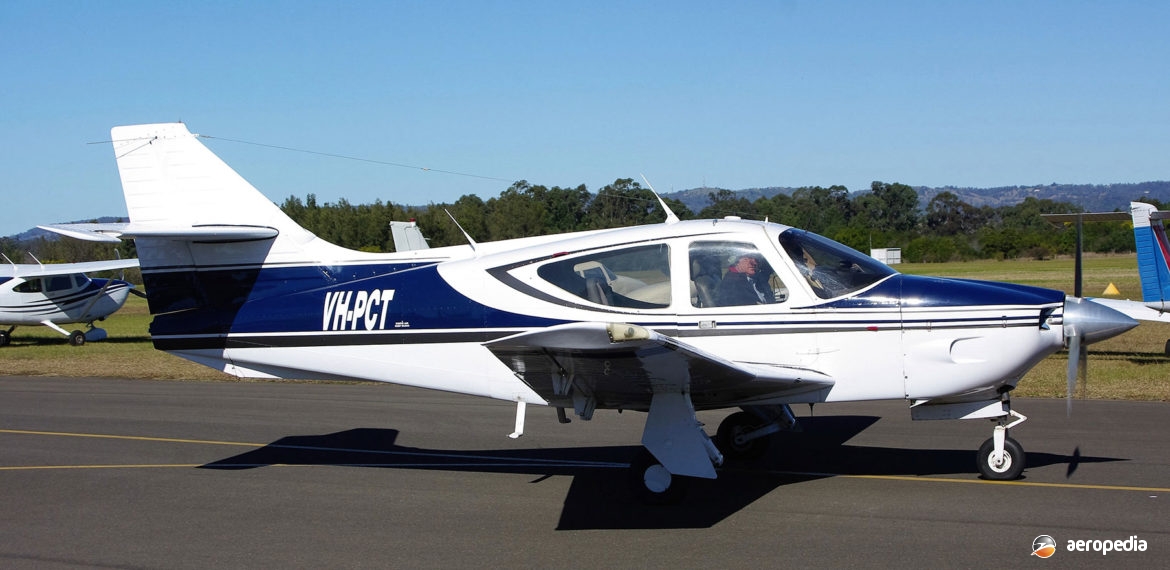Photograph:
Rockwell Commander 112 VH-PCT (c/n 230) at Camden, NSW (David C Eyre)
Country of origin:
United States of America
Description:
Four-seat light touring aircraft
Power Plant:
One 149 kw (200 hp) Lycoming IO-360C1D6 four-cylinder horizontally-opposed air-cooled engine
Specifications:
- Wingspan: 9.98 m (32 ft 9 in)
- Length: 7.56 m (24 ft 10 in)
- Height: 2.56 m (8 ft 5 in)
- Wing area: 15.2 m² (164 sq ft)
- Max speed at sea level: 275 km/h (171 mph)
- Cruising speed: 259 km/h (161 mph)
- Stalling speed (clean): 113 km/h (70 mph)
- Stalling speed in landing configuration: 100 km/h (62 mph)
- Rate of climb at sea level: 311 m/min (1,020 ft/min)
- Service ceiling: 4,237 m (13,900 ft)
- Take-off distance to clear 15 m (50 ft) obstacle: 483 m (1,585 ft)
- Landing distance over 15 m (50 ft) obstacle: 399 m (1,310 ft)
- Cruising range at 75% power with 182 litres fuel (40 imp gals): 953 km (592 miles)
- Cruising range at 55% power with 257 litres (57 imp gals) of fuel: 1,569 km (975 miles)
- Empty weight: 766 kg (1,688 lb)
- Useful load: 436 kg (962 lb)
- Loaded weight: 1,202 kg (2,650 lb)
History:
The first of a new series of single-engine monoplanes, the prototype Commander 112 was flown for the first time on 4 December 1970 powered by a 134 kw (180 hp) Lycoming O-360 engine. A further four prototypes followed before customer deliveries commenced in 1972. A fixed undercarriage version was also released at this time and, known as the Model 111, flew for the first time in September 1971 but only two were produced. The Model 112 had the most spacious cabin of any single-engine four-seat aircraft on the market at that time. Passenger access was through a door on each side and production aircraft had a 149 kw (200 hp) IO-360 fuel-injected engine. Production of the series took place at the General Aviation Division of Rockwell International at Bethany, Oklahoma, USA.
In 1974 the 112A was introduced to succeed the 112, this model having a strengthened structure, metal doors rather than fibreglass cabin doors, better cabin ventilation and an increase in loaded weight to 1,202 kg (2,650 lb). The 112TC was introduced at the same time, fitted with a 157 kw (210 hp) turbo-charged Lycoming TIO-360-C1AD engine and an auto-boost system, controlled through the throttle, driving a Hartzell two-blade propeller 1.96 m (6 ft 5 in) in diameter, extended wings, and an increased overall span by 0.88 m (2 ft 10½ in) to 10.86 m (35 ft 7½ in).
Later again the Model 112B appeared with new disc brakes, larger wheels, the extended wingspan of the 112TC and improved sound-proofing. This model was discontinued in February 1978. Accommodation was provided for a pilot and three passengers with a baggage compartment with a capacity of 91 kg (200 lb). The TC had a Lycoming TIO-360-C1AD four-cylinder engine rated at 157 kw (210 hp) and had a max speed of 307 km/h (191 mph) at 4,575 m (15,000 ft).
Total production of this series comprised: Model 111 – 2; Model 112 – 125; Model 112A – 363; Model 112B – 44; Model 112TC – 109; and Model 112TC-A / Alpine Commander – 160.

